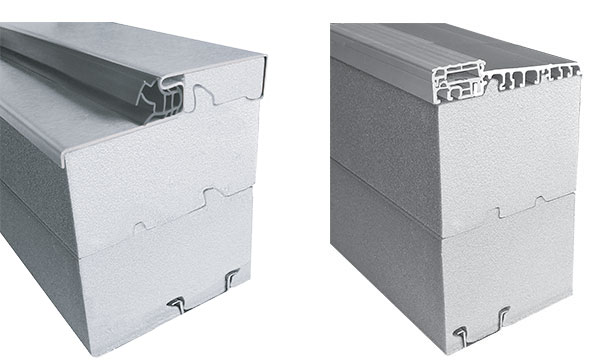Which thermal standard to choose for a given type of building?
The thermal insulation of a door is best illustrated by the heat transfer coefficient Ud. It determines how much heat will „escape” through a 1 m2 door. The lower the Ud value is, the better the material protects against heat loss. This means that twice as much heat will escape through a door with a coefficient of Ud = 0,75 W/m2K than through a door with a coefficient of Ud = 1,4 W/m2K.
Technical requirements for doors depending on the type of building
A rational rule when choosing the thermal standard of doors is to align it with the energy standard of the entire building. Of course, the more thermally efficient a door is, the higher the thermal comfort and the greater the savings on heating will be.
Apartments
Entrance to an apartment from a heated staircase
Unheated rooms
Interior doors
There are heated rooms on both sides of the door
Martom's recommendations
SPECIAL DOORS AND THE OPTIMAL STANDARD
According to EU standards, beginning in 2017, doors installed in heated buildings should have a Ud coefficient lower than 1.5 W/m2K. This is a legal requirement for newly built buildings. In the case of renovated buildings, this is a recommendation. Martom also recommends this factor as a minimum for entry doors which lead to apartments from cold or poorly heated staircases
Martom's recommendations
ALL MARTOM DOORS
Energy-efficient houses
An energy-efficient house (low-energy house-LEH; Polish designation NF40) is a building in which the annual heat demand is lower than 70 kWh/(m2/year).
Martom's recommendations
PASSIVE, ARKTIC AND UNGLAZED NORDIC MODELS
Passive houses
A passive house (PH, designation NF15) is one in which the annual energy demand does not exceed 15 kWh/(m2/year).
Martom's recommendations
PASSIVE
If the door is installed in the raw state, there will be free space between the door threshold and the foundation, because at this stage there is no thermal insulation or floor screed. This forms a thermal and humidity bridge which is very „difficult” to secure properly. It can cause many problems in the future, e.g. freezing of the threshold, fungus on the wall and floor, damage to the parquet floor, etc.
Martom offers two types of extensions for thresholds (called „sills”), which are a very good solution to this problem

Systemic sill made of dense XPS. The profile is adapted to the shape of the threshold so as to ensure full tightness. This product is available at a very attractive price and is recommended for doors with no side or transom windows and of moderate weight.

Sills made of Klinaryt (a specially hardened expanded polystyrene). This material can carry very high loads and is perfect even for heavy doors with side or transom windows. The profile is systemically adjusted to fit the thresholds. Available heights: 7, 10, 16, 20cm (only in straight lengths of 1.2m). For a proper connection between the extension and the threshold, it is necessary to use a special BOSTIK adhesive on the connection.
The Ud heat transfer coefficient of a door determines how many joules [J] of heat will escape through a door surface of 1 m2 within 1 second [s] if the temperature difference on both sides of the door is 1 degree [K]. It is important to compare the Ud coefficients for the whole door, i.e. taking into account not only the parameters of the warmest element, i.e. the leaf, but also the frame and threshold.
BURGLARY RESISTANCE CLASSES ACCORDING TO EUROPEAN STANDARDS
In everyday language the term „burglar-proof door” is used. In practice, a burglar-proof door do not exist, because any door can be forced open. The question is what tools need to be used for the task, how long it will take and how much noise it will generate. Burglary resistance classes are specified in the European standard PN-EN 1627:2012. Acting in accordance with this standard, a highly qualified technician will attempt to force through various types of doors using a specific set of tools. If a door withstands an attempt with a given tool set longer than the time specified in the standard, then it can be marked with the given RC resistance class. The assumptions of the standard are specified in the table below.
No tools used:

MINIMUM RESISTANCE TIME
no tests
Attempted burglary using simple tools such as:

MINIMUM RESISTANCE TIME
3 minutes
Attempted burglary using tools such as:

MINIMUM RESISTANCE TIME
5 minutes
Tools listed to the side, plus:

MINIMUM RESISTANCE TIME
10 minutes
CONCLUSIONS
The conclusions from the above list are that even RC1 and RC2 doors are a significant barrier for opportunist and unprepared burglars. Most of them will be discouraged after the first unsuccessful attempts to force the door open. RC3 and RC4 class doors are completely inaccessible to opportunist burglars, and even to the experienced and well prepared burglar they are a barrier that will require the use of noisy tools. Especially in the case of apartments, where noise will certainly draw the attention of neighbours, this is an extremely effective type of protection.
Electronic security systems combined with security agency services are becoming more and more common. When an attempt is made to break in, an alarm is sounded and the response group is notified, which reaches the scene in a short time. Every additional minute spent by burglars on forcing through doors can be crucial in such a situation.
When choosing a door it is also worth to consult with an insurance company. Many will require security measures of the appropriate class to ensure your home or apartment is protected against burglary, and often this will lead to substantial discounts.
MARTOM’s retail offer includes doors with an RC2 and RC3 class, while the investment offer has RC4 doors.
Burglary resistance classes RC2, RC3 and RC4 apply to solid doors, but a significant increase in security can also be achieved in the case of glazed doors with the addition of additional security elements such as the ROTO QB flat lock, a handle or insert with a resistance class, etc.
The loudness of sound perceived by the human brain changes logarithmically to the changes in decibels. This means that a 6dB change in intensity doubles the effect heard by the human ear. Or in other words, a 20dB increase in loudness increases the audible effect 10 times and a 40dB increase increases the audible effect 100 times.
Improved soundproofing of doors by as much as 1dB significantly reduces the audible effect and greatly improves acoustic comfort.
Prolonged exposure to noise of more than 35dB has a very adverse effect on human health. Such noise can be caused even by a conversation or traffic of medium intensity. This leads to nervous system fatigue, impedes speech recognition, concentration and relaxation, and causes stress. It can cause nervousness and even aggression. In the long term, this can lead to more serious health problems, such as cardiovascular disorders.
Standards allow an average noise level of 40dB during daytime and 30dB at night in residential areas such as bedrooms or children’s rooms. Full acoustic comfort is provided in rooms where the noise does not exceed 20dB.
The standard Martom door offers soundproofing (noise reduction) of approx. 30dB. This is a high level of noise reduction, which in many situations is completely sufficient. With a sound level of approx. 50 – 65dB outside, the standard Martom door reduces the noise to a comfortable level of around 20 – 35dB.
The loudness of sounds penetrating through a door with a sound insulation factor of 37dB is more than twice as low when compared to a standard 30dB door. 37dB doors will also reduce 60 – 75dB noises to an acceptably comfortable level.
42dB doors reduce sound levels by up to 4 times compared to standard doors. They reduce 65 – 80dB noises to a comfortable level.
TWO OR EVEN THREE IN ONE
All Martom acoustic doors offer an increased burglary resistance class and some also provide fire protection. In the retail offer, there are 4 standards of acoustic doors: RC2 42dB, RC2 42dB EI30, RC3 42dB, RC3 42dB EI30. In case of larger quantities, the RC4 42dB „investment product” is also available.
RC3 42dB doors are particularly popular. These doors are equipped with a ROTO QB flat lock which ensures exceptional tightness, safety and comfort of use. These products are chosen mainly by clients who live in multi-family buildings and who appreciate peace and quiet. In addition to dampening the noise coming into the apartment from the staircase, acoustic doors also protect the privacy of the residents.
The phenomenon of sound attenuation is very complex. Among other things, the acoustic wavelength is of great importance. Therefore, the soundproofing parameters determined in the normative test should be treated as averaged parameters. For reduction of unusual and intensive noise sources, we recommend consultation with a specialist who will select the optimal solution.
Fire doors are classified according to how long they resist flames and remain tight. For example, doors marked with EI30 remain flame-tight for 30 minutes. The designation Sa, Sm means that for a period of 30 minutes, the rate at which smoke flows through the connection between the leaf and the frame will remain low and safe for people. Toxic smoke poses a greater risk to human life and health than fire, as it causes death before the temperature rises to dangerous levels.
Rooms located on upper floors can become a deadly trap in the event of a fire. Delaying the access of fire and toxic smoke by e.g. 30 minutes can in many cases be a matter of life or death. Therefore, in new residential or office investments, the law enforces the use of fire doors.
In single-family housing projects it is often required to use fire doors, e.g. as a wicket door from the boiler room to the garage and in other situations required by law. Unfortunately, this provision is often ignored by investors. This can have serious consequences in the event of a fire, as it is a premise for insurance companies to withhold compensation.
Fire doors are worth installing not only because of the regulations. This applies especially to boiler room or garage doors. If flammable substances or valuable items (e.g. a collection of books or paintings) are stored in any of the other rooms, it makes sense to install fire doors there as well. The use of fire and smoke protection doors in industrial, public and multi-family buildings is regulated by construction law.
TRIPLE PROTECTION
All MARTOM fire doors offer an increased anti-burglary and acoustic class. The retail offer includes 2 standards for fire doors: RC2 42dB EI30 SaSm oraz RC3 42dB EI30 SaSm.
We observe a very large increase in sales of RC3 42dB EI30 SaSm doors. They are mainly chosen by conscious customers living on higher floors of multi-family buildings.